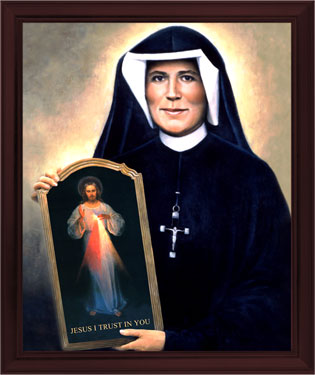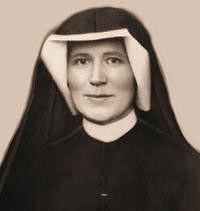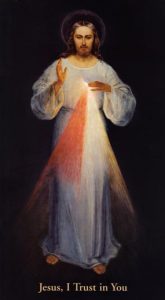
5 October
St. Maria Faustina Kowalska (1905-1938)
Apostle of Divine Mercy
Born: 25 August 1905, Głogowiec, Poland
Died: October 5, 1938, Kraków, Poland
Canonized: 30 April 2000, Pope John Paul II
Major Shrine: Shrine of Divine Mercy in Łagiewniki, Kraków, Poland
COLLECT PRAYER
O God, who in a wondrous manner revealed the inexhaustible riches of your mercy to Saint Maria Faustina, grant, we beseech you, that by looking with trust upon the pierced side of your Son we may be strengthened to show mercy one to another and, at length, sing forever of your mercy in heaven. Through our Lord Jesus Christ, your Son, who lives and reigns with you in the unity of the Holy Spirit, God, forever and ever.
On October 5, the church celebrates the Memorial of St. Mary Faustina Kowalska, virgin.
St. Faustina was born Helena Kowalska on August 25, 1905 to a poor but devout Polish family in 1905. At the age of 20, with very little education, and having been rejected from several other convents because of her poverty and lack of education, Helen entered the Congregation of the Sisters of Our Lady of Mercy. There, she took the name Sr. Faustina and spent time in convents in both Poland and Lithuania.
Throughout her life, Jesus appeared to Sr. Faustina. He asked her to become an apostle and secretary of his mercy, by writing down his messages of Divine Mercy for the world in her diary. Jesus also asked Sr. Faustina to have an image painted of his Divine Mercy, with red and white rays issuing from his heart, and to spread devotion to the Divine Mercy novena. Even before her death on October 5, 1938, devotion to Divine Mercy began to spread throughout Poland.This little nun and Jesus’ message of Divine Mercy impacted Karol Wojtyla greatly, which became obvious to the world when he was elected Pope. “It is truly marvelous how her devotion to the merciful Jesus is spreading in our contemporary world and gaining so many human hearts! This is doubtlessly a sign of the times — a sign of our twentieth century. The balance of this century, which is now ending, in addition to the advances which have often surpassed those of preceding eras, presents a deep restlessness and fear of the future. Where, if not in the Divine Mercy, can the world find refuge and the light of hope? Believers understand that perfectly,” Pope St. John Paul II wrote.
On April 30, 2000, Pope John Paul II canonized St. Faustina in what he was widely reported as saying was “the happiest day of my life.” “Today my joy is truly great in presenting the life and witness of Sr Faustina Kowalska to the whole Church as a gift of God for our time. By divine Providence, the life of this humble daughter of Poland was completely linked with the history of the 20th century, the century we have just left behind. In fact, it was between the First and Second World Wars that Christ entrusted his message of mercy to her. Those who remember, who were witnesses and participants in the events of those years and the horrible sufferings they caused for millions of people, know well how necessary was the message of mercy,” the Pope said in his homily that day. It was also on this day, the Sunday after Easter, that Pope John Paul II instituted the Feast of Divine Mercy, which Jesus had asked for in his messages to Sr. Faustina.
Source: Catholic News Agency (CNA)
Things to Do:
- Read a short biography of Sr. Mary Faustina Kowalska from the Vatican.
- Read the Holy Father’s April 30, 2000 Homily at the solemn Mass celebrated for the canonization of Sr. Mary Faustina Kowalska.
- From the Directory on Popular Piety and Liturgy: Devotion to the Divine Mercy
In connection with the octave of Easter, recent years have witnessed the development and diffusion of a special devotion to the Divine Mercy based on the writings of Sr. Faustina Kowalska who was canonized 30 April 2000. It concentrates on the mercy poured forth in Christ’s death and resurrection, fount of the Holy Spirit who forgives sins and restores joy at having been redeemed. Since the liturgy of the Second Sunday of Easter or Divine Mercy Sunday — as it is now called — is the natural locus in which to express man’s acceptance of the Redeemer’s mercy, the faithful should be taught to understand this devotion in the light of the liturgical celebrations of these Easter days. Indeed, “the paschal Christ is the definitive incarnation of mercy, his living sign which is both historico-salvific and eschatological. At the same time, the Easter liturgy places the words of the psalm on our lips: “I shall sing forever of the Lord’s mercy” (Ps 89[88]: 2). - Read more from our Catholic Culture library about the Divine Mercy devotion, in particular, a short description of The Divine Mercy devotion
- St. Faustina came from Poland. John Paul II was also Polish, and had a great devotion to the Divine Mercy. He made it a feast day on the second Sunday after Easter. Find out more about Poland and its customs. It’s a very Catholic country, with deep devotion to Our Lady. A wonderful book that gives a wonderful understanding of the culture is the Pope’s biography A Witness to Hope by George Wiegel. This site contains many Polish Traditions. The Polish Art Center has many resources for Polish customs.

St. Faustina Kowalska, Virgin
Saint Faustina was born in the 20th century, and canonized in the year 2000. Jesus chose her to deliver to the modern world a message as old as eternity. It is the message of his love for all people, especially sinners. Jesus said to Faustina, “Today I am sending you with my mercy to the people of the whole world.” It is his desire to heal the aching world, to draw all people into his merciful heart of love.
On February 22, 1931, Jesus appeared to Faustina as the King of Divine Mercy. He asked her to have a picture painted of him as she saw him — clothed in white, with red and white rays of light streaming from his heart. The rays represent the blood and water that flowed from the side of Jesus on the cross. Under the image are the words, “Jesus, I trust in you.”
Many people did not believe Faustina at first. The sisters in her own convent thought that Jesus could not possibly have selected her for this great favor. After all, she was an uneducated peasant girl. Her superiors often refused to give her permission to carry out Jesus’ requests. Church theologians, too, doubted her word. Jesus told Faustina that he loved her obedience and that his will would be done in the end.

In June 1934 an artist completed the painting of the Divine Mercy according to her instructions; and it soon became a focus for devotion. Faustina continued to record in her diary the appearances of Jesus. The diary was translated into English and published in 1987 with the title Divine Mercy in My Soul.
Faustina, baptized Helena, had grown up in a poor Polish family of 10 children. When she was 15 years old, she quit school in order to work as a housemaid to help support her family. By the time she was 18, she was sure that God was calling her to a religious life, but her parents objected. So she tried to put it out of her mind. But one night, while the lively polka music was playing at a village dance, Helena saw Jesus, sad and suffering. The very next day she packed a small bag and went to the capital city of Warsaw to join the Sisters of Our Lady of Mercy. There she received the name Sister Mary Faustina.
About 10 years later, Faustina contracted tuberculosis. Soon she was too weak to manage the heavy gardening assigned to her. So she was given the job of gatekeeper. She was able to show mercy to the poor people who came to the convent looking for food. Once Jesus came to the door as a poor young man. After he had eaten the soup and bread Faustina gave him, she recognized him. Jesus told her he had come to experience with great joy her tender love and mercy.
Faustina was canonized by the first Polish pope, John Paul II, on April 30, 2000. The first Sunday after Easter was declared Divine Mercy Sunday.
Excerpted from Saints and Feast Days:
A Resource and Activity Book by The Sisters of Notre Dame of Chardon, Ohio.
Source: CATHOLIC CULTURE
Jesus to Faustina (Excerpts from Faustina’s Diary)
Diary 1146 – [Let] the greatest sinners place their trust in My mercy. They have the right before others to trust in the abyss of My mercy. My daughter, write about My mercy towards tormented souls. Souls that make an appeal to My mercy delight Me. To such souls I grant even more graces than they ask. I cannot punish even the greatest sinner if he makes an appeal to My compassion, but on the contrary, I justify him in My unfathomable and inscrutable mercy.
Diary 723 – The greater the sinner, the greater the right he has to My mercy. My mercy is confirmed in every work of My hands. He who trusts in My mercy will not perish, for all his affairs are Mine, and his enemies will be shattered at the base of My footstool.
Diary 327 – I am offering people a vessel with which they are to keep coming for graces to the fountain of mercy. That vessel is this image with the signature: “Jesus, I trust in You.”
Diary 299 – These rays shield souls from the wrath of My Father. Happy is the one who will dwell in their shelter, for the just hand of God shall not lay hold of him. I desire that the first Sunday after Easter be the Feast of Mercy.
Some more excerpts from St Faustina’s Diary at NATIONAL CATHOLIC REGISTER